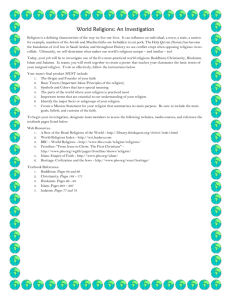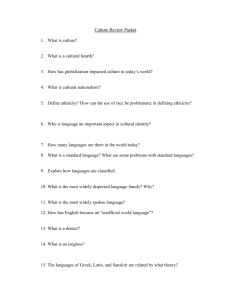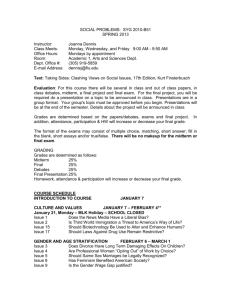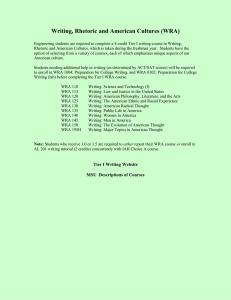"Religions of the World" (Arnold) - Wabash Center for Teaching and
advertisement
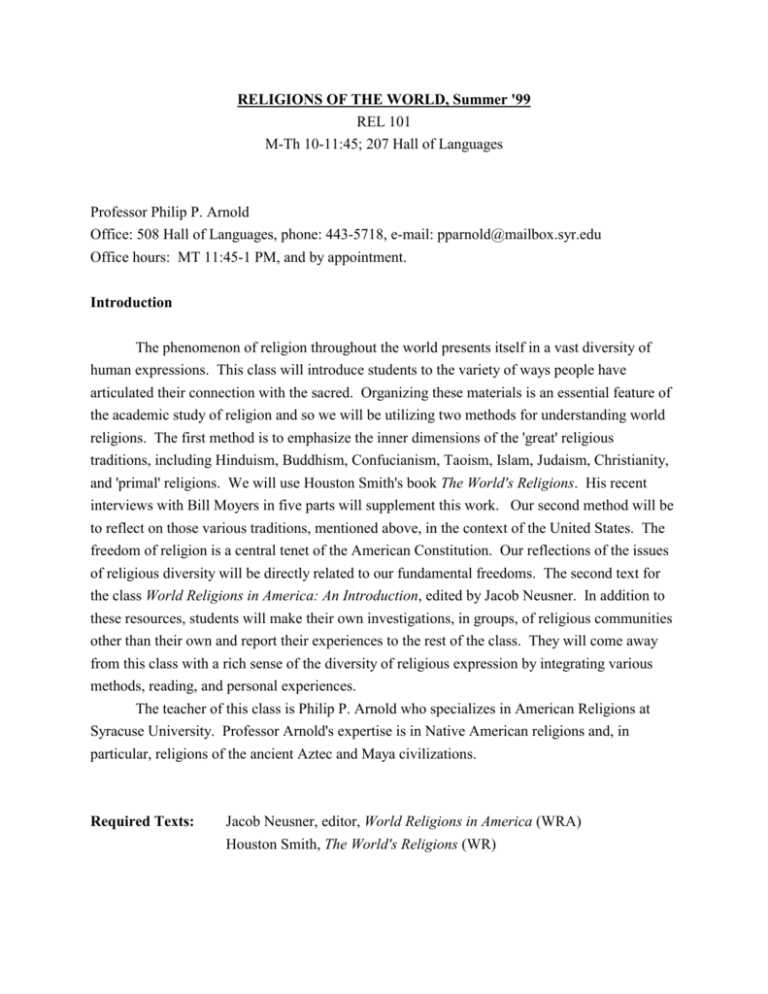
RELIGIONS OF THE WORLD, Summer '99 REL 101 M-Th 10-11:45; 207 Hall of Languages Professor Philip P. Arnold Office: 508 Hall of Languages, phone: 443-5718, e-mail: pparnold@mailbox.syr.edu Office hours: MT 11:45-1 PM, and by appointment. Introduction The phenomenon of religion throughout the world presents itself in a vast diversity of human expressions. This class will introduce students to the variety of ways people have articulated their connection with the sacred. Organizing these materials is an essential feature of the academic study of religion and so we will be utilizing two methods for understanding world religions. The first method is to emphasize the inner dimensions of the 'great' religious traditions, including Hinduism, Buddhism, Confucianism, Taoism, Islam, Judaism, Christianity, and 'primal' religions. We will use Houston Smith's book The World's Religions. His recent interviews with Bill Moyers in five parts will supplement this work. Our second method will be to reflect on those various traditions, mentioned above, in the context of the United States. The freedom of religion is a central tenet of the American Constitution. Our reflections of the issues of religious diversity will be directly related to our fundamental freedoms. The second text for the class World Religions in America: An Introduction, edited by Jacob Neusner. In addition to these resources, students will make their own investigations, in groups, of religious communities other than their own and report their experiences to the rest of the class. They will come away from this class with a rich sense of the diversity of religious expression by integrating various methods, reading, and personal experiences. The teacher of this class is Philip P. Arnold who specializes in American Religions at Syracuse University. Professor Arnold's expertise is in Native American religions and, in particular, religions of the ancient Aztec and Maya civilizations. Required Texts: Jacob Neusner, editor, World Religions in America (WRA) Houston Smith, The World's Religions (WR) 2 Topics Assignments July 7 Introductions--what is religion? 8 12 World Religions in America WR IX, WRA Intro. & 14 Guest speaker: Professor Richard Pilgrim Native American/'Primal' religions WRA 1 13 Hinduism 14 Hinduism in America WRA 8 Film: Pilgrimage to Pittsburgh (610445, VH) Buddhism WR III 15 19 WR I & II 20 Buddhism in America WRA 9 Film: Buddhism: The Land of the Disappearing Buddha--Japan (609220, VH) Confucianism WR IV 21 Taoism 22 WR V Film: Taoism: Question of Balance (609222, VH) MIDTERM EXAM 26 Judaism 27 Judaism im America WRA 7 Film: Ritual Three Portraits of Jewish Life (610234, VH) Christian Catholicism & Orthodoxy WRA 4 & 6 28 29 WR VII Christian Protestantism WR VIII, & WRA 2 Film: Protestant Spirit USA (609212, VH) August 2 Islam WR VI 3 4 Islam in America WRA 11 Film: Islam in America the Next Decade, 1990s in Transition (610313, VH) Religion and ethnicity WRA 5 & 10 5 Religion, politics, and gender 9 Group presentations 10 Group presentations WRA 3, 12, & 13 3 11 Group presentations and final review 12 FINAL EXAMINATION 4 Grading Final grades will be based on a midterm exam, a final exam, group presentations, a final paper and class participation. Midterm and final exams: The midterm and final exams will constitute the major portion of your final grade. The midterm is worth 30 points and the final is worth 30 points. Each of these exams will be composed of short identification questions and essays. These exams will be designed to reflect material covered in films, lectures and reading--so it is to your advantage to familiarize yourself with all the class material. Both exams will require you to do a substantial amount of writing in class. Particularly helpful in preparing for these exams is diagramming your answers to short identifications and essay questions. Group presentations and papers: Early on in the class you will have the opportunity of forming small groups. Each group will investigate a religionother than their own. There are several useful resources for this task. We will be using the CD ROM On Common Ground in class which will be available to you at the Media Services in Bird Library. Also there are several useful reference works including the Encyclopedia of Religion and websites that can be accessed through the Pluralism Project webpage at Harvard University (http://www.fas.harvard.edu/~pluralsm/). Groups can also visit different religious communities in our area. The "Interreligious Council Directory" lists contact people from diverse religious communities in this area and is available to the class at Hendricks Chapel. In addition to the class presentation each student will be responsible for writing a short paper. This should be typed from 3 to 5 pages in length, double spaced, 12 pt. Both the presentation and paper will count for 30 points of your final grade. The criteria below is what will use when grading your exams and written assignments: 1) Clarity. The viewpoints you present in your writing must be clearly conceived and well argued. Your writing style should be straight-forward, easy to read and should be clearly related to the issues you wish to address. Topic sentences at the beginning of each paragraph are helpful in establishing the issue and argument for the reader at the outset. (40%) 2) Engagement with the material. Entries are to be related to the reading material. They are not reviews of what has been stated in the book but are your critical analysis of the reading. Avoid direct quotes. Instead seriously take-up what you consider to be the ‘key’ issues for the study of religion in the reading. An analysis of the issues discussed in the course become clearer the closer your writing is to the texts used in class. (40%) 3) Creativity. The ‘work’ of Religious Studies, and perhaps the Humanities in general, is essentially creative. Interpretation of religious phenomena requires that you come to some meaningful relationship with your object of study. This is one of the defining characteristics of creativity. You have a unique and important contribution to make to our collective understandings. There are no predetermined experts in the area of religion, only well refined and well argued posi-tions. Your interpretations will be dealt with as importantly as you regard them yourself. (20%) Attendance and class participation: Attendance is mandatory for this class. Lectures and reading will be intimately related but quite different. It is therefore in your own best interest to do the reading and attend class as both will reflect on your performance on discussion topic 5 papers, the midterm, and final. You will be given regular opportunities to participate in class by either asking questions, making comments, and interacting with other students in discussion. Final grades will be determined as follows: Midterm Final exam Group presentations and paper Attendance and class participation 30 points 30 points 30 points 10 points 6 Definitions of Religion: Compiled by Professor Ann Gold for Religion 101/98 1. Ludwig Feuerbach, 1841 " . . . is man's earliest and also indirect form of self-knowledge. . . . " . . . is the childlike condition of humanity . . . . " . . . is the dream of the human mind. But even in dreams we do not find ourselves in emptiness or in heaven, but on earth, in the realm of reality." 2. Karl Marx, 1844 " . . . is the sigh of the oppressed creature. . . . " . . . is only the illusory sun which revolves around man as long as he does not revolve around himself. " . . . the fantastic realization of the human essence because the human essence has no true reality. The struggle against religion is therefore . . . the fight against the other world, of which religion is the spiritual aroma. 3. Eward Tylor, 1871 " . . . [is] the belief in Spiritual Beings." 4. Vivekananda, c. 1893 " . . . is the manifestation of the Divinity already in man." 5. Emile Durkheim, c. 1915 " . . . is a unified system of beliefs and practices relative to sacred things, that is to say, things set apart and forbidden--beliefs and practices which unite into one single moral community called a Church, all those who adhere to them." 6. Sigmund Freud, 1927 "Religious ideas are teachings and assertions about facts and conditions of external (or internal) reality which tell one something one has not discovered for oneself and which lay claim to one's belief. Since they give us information about what is most important and interesting to us in life, they are particularly highly prized. . . . . We must ask where the inner force of those doctrines lies and to what it is that they owe their efficacy, independent as it is of recognition by reason. . . . religious beliefs . . . are illusions, fulfillments of the oldest, strongest and most urgent wishes of mankind. The secret of their strength lies in the strength of those wishes." 7. Alfred North Whitehead, c. 1927 " . . . is what the individual does with his own solitariness; and if you were never solitary, you were never religious." 8. Bronislaw Malinowski, 1931 " . . . is not born out of speculation or reflection, still less out of illusion or misapprehension, but rather out of the real tragedies of human life, out of the conflict between 7 human plans and realities. . . . . Every important crisis of human life implies a strong emotional upheaval, mental conflict and possible disintegration. . . . . Religious belief consists in the traditional standardization of the positive side in the mental conflict and therefore satisfies a definite individual need . . . . On the other hand, religious belief and ritual, by making the critical acts and the social contracts of human life public, traditionally standardized, and subject to supernatural sanctions, strengthen the bonds of human cohesion. 8 9. Carl Jung, 1938 " . . . appears to me to be a peculiar attitude of the human mind, . . . that is, a careful consideration and observation of certain dynamic factors, understood to be 'powers,' spirits, demons, gods, laws, ideas, ideals or whatever name man has given to such factors as he has found in his world powerful, dangerous or helpful enough to be taken into careful consideration, or grand, beautiful and meaningful enough to be devoutly adored and loved. . . . 'Religion,' it might be said, is the term that designates the attitude peculiar to a consciousness which has been altered by the experience of the numinosum." 10. Mohandas Gandhi, c. 1940 " . . . is the permanent element in human nature which counts no cost too great in order to find full expression and which leaves the soul utterly restless until it has found itself, known its Maker and appreciated the true correspondence between the Maker and itself. . . . . Religion is to morality what water is to the seed that is sown in the soil." 11. Robert Lowie, 1952 " . . . is verily a universal feature of human culture, not because all societies foster a belief in spirits, but because all recognize in some form or other awe-inspiring, extraordinary manifestations of reality. . . . those cultural phenomena . . . which center about or are somehow connect with the sense of mystery or weirdness." 12. Paul Tillich, 1963 " . . . is the state of being grasped by an ultimate concern, a concern which qualifies all other concerns as preliminary and which itself contains the answer to the question of the meaning of our life. Therefore this concern is unconditionally serious and shows a willingness to sacrifice any finite concern which is in conflict with it. The predominant religious name for the content of such a concern is God -- a god or gods. 13. Clifford Geertz, 1966 " . . . is a system of symbols which acts to establish powerful, pervasive, and long-lasting moods and motivations in men by formulating conceptions of a general order of existence and clothing these conceptions with such an aura of factuality that the moods and motivations seem uniquely realistic." 14. Peter Berger, 1967 " ...is the audacious attempt to conceive of the entire universe as being humanly significant. 15. Frederick Streng, 1969 " . . . is . . . a means of ultimate transformation. This definition focuses on the dynamic process of change in religious life, a change from a disharmonious, illusory, evil, or destructive state of existence to ultimate harmony, enlightenment, purity, or creative power." 16. Daniel Bell, 1980 [summarized by Mary Douglas] [offers] " . . . a set of coherent answers to the universal existential problems of mankind. Its answers may be codified into a creed and celebrated with rites, and these may be established 9 in institutions. The general effect of religion is to create coherence in experience and emotional bonds between those who adhere to the credal form." 17. Charles H. Long, 1986 " . . . will mean orientation--orientation in the ultimate sense, that is, how one comes to terms with the ultimate significance of one's place in the world. . . . . The religion of any people is more than a structure of thought; it is experience, expression, motivations, intentions, behaviors, styles, and rhythms." 18. Cornell West, 1994 [means] " . . . ligare, to bind; religare, to rebind in the midst of deep crisis, in the midst of scars and bruises and wounds and heartaches and heartbreaks and sadness and sorrow. We can also begin anthropologically and look at religion from a more basic level: we frivolous, two legged, linguistically conscious creatures, born between urine and feces, we must weave some webs of meaning and significance as we face inevitable and inescapable extinction. We are not here that long. In order to make this short sojourn meaningful, of some significance, we must come up with some sense of a story, a narrative, a ritual in a community, some bonds of affection, some networks of support, some cords or ties of empathy and sympathy and compassion."




